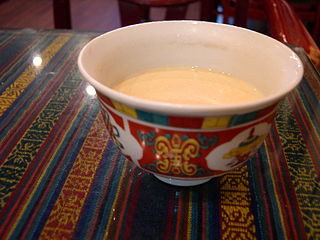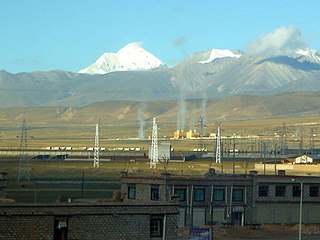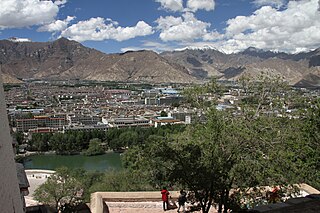This article lists the major power stations located in Tibet .
| Station | Name in Chinese | Coordinates | Capacity (MW) | Operational Units and (type) | Under Construction Units | Planned Units | Decommissioned Units(Year) | Reference |
|---|---|---|---|---|---|---|---|---|
| Dongga Power Station | 东嘎电厂 | 29°39′17″N90°57′30″E / 29.65472°N 90.95833°E | 283.7 | 1*180MW(gas), 9*11.52MW(fuel), |
| Station | Name in Chinese | Coordinates | River | Total Capacity (MW) | Dam Height (meters) | Status | Units |
|---|---|---|---|---|---|---|---|
| Yamdrok Hydropower Station | 羊卓雍湖抽水蓄能电厂 | Inlet 29°11′11″N90°35′47″E / 29.18639°N 90.59639°E , Outlet 29°15′51″N90°36′24″E / 29.26417°N 90.60667°E | Yamdrok Lake | 112.5 | Operational | 5 x 22.5MW | |

Dalai Lama is a title given by the Tibetan people to the foremost spiritual leader of the Gelug or "Yellow Hat" school of Tibetan Buddhism, the newest and most dominant of the four major schools of Tibetan Buddhism. The 14th and incumbent Dalai Lama is Tenzin Gyatso, who lives in exile as a refugee in India. The Dalai Lama is also considered to be the successor in a line of tulkus who are believed to be incarnations of Avalokiteśvara, the Bodhisattva of Compassion.

Tibet is a region in the central part of East Asia, covering much of the Tibetan Plateau and spanning about 2,500,000 km2 (970,000 sq mi). It is the homeland of the Tibetan people. Also resident on the plateau are some other ethnic groups such as the Monpa, Tamang, Qiang, Sherpa and Lhoba peoples and, since the 20th century, considerable numbers of Han Chinese and Hui settlers. Since the annexation of Tibet by the People's Republic of China in 1951, the entire plateau has been under the administration of the People's Republic of China. Tibet is divided administratively into the Tibet Autonomous Region, and parts of the Qinghai and Sichuan provinces. Tibet is also constitutionally claimed by the Republic of China as the Tibet Area since 1912.

The Tibet Autonomous Region or Xizang Autonomous Region, often shortened to Tibet or Xizang, is an autonomous region of the People's Republic of China (PRC) in Southwest China. It was overlayed on the traditional Tibetan regions of Ü-Tsang and Kham.

Lhasa is the urban center of the prefecture-level Lhasa City and the administrative capital of Tibet Autonomous Region in southwest China. The inner urban area of Lhasa City is equivalent to the administrative borders of Chengguan District, which is part of the wider prefectural Lhasa City.

Lhünzhub County is a county in Lhasa towards the north-east of the main center of Chengguan, Tibet, China. It covers an area of 4,512 km2 (1,742 sq mi) and as of 2000 had a population of 50,895 people, almost all classified as rural. The southern portion, the Pengbo River Valley, contains fertile arable land, while the colder and more mountainous northern portion primarily supports grazing. The county has many monasteries, including the Reting Monastery.

Doilungdêqên District is a district in Lhasa, north-west of the main center of Chengguan, Tibet Autonomous Region. It is largely agricultural or pastoral, but contains the western suburbs of the city of Lhasa. The Duilong River runs southeast through the district to the Lhasa River. A prehistoric site appears to be 3600–3000 years old. The district is home to the Tsurphu Monastery (1189) and the 17th century Nechung monastery.

Maizhokunggar County or Meldro Gungkar County is a county of Lhasa and east of the main center of Chengguan, Tibet Autonomous Region. It has an area of 5,492 square kilometres (2,120 sq mi) with an average elevation of over 4,000 metres (13,000 ft). Most of the people are ethnic Tibetan and are engaged in agriculture or herding. Mining is a major source of tax revenue, but has created environmental problems. The county has various tourist attractions including hot springs and the Drigung Monastery.

Butter tea, also known as Bho jha, cha süma, is a drink of the people in the Himalayan regions of Nepal, Bhutan, India especially in Kashmir and Gilgit-Baltistan, Pakistan’s northern region called Khyber Pakhtunkhwa, Afghanistan, Kazakhstan, Tajikistan, East Turkestan, Tibet and western regions of modern-day China, Central Asia and the Caribbean. Traditionally, it is made from tea leaves, yak butter, water, and salt, although butter made from cow's milk is increasingly used, given its wider availability and lower cost.

The following outline is provided as an overview of and topical guide to Tibet:

The CIA Tibetan program was an anti-Chinese covert operation spanning almost twenty years. It consisted of "political action, propaganda, paramilitary and intelligence operations" facilitated by arrangements made with brothers of the 14th Dalai Lama, who himself was not initially aware of them. The stated goal of the program was "to keep the political concept of an autonomous Tibet alive within Tibet and among several foreign nations". The program was admininstrated by the CIA, and unofficially operated in coordination with domestic agencies such as the Department of State and the Department of Defense.
The Zangmu Dam (藏木) is a gravity dam on the Yarlung Zangbo/Brahmaputra River 9 km (5.6 mi) northwest of Gyaca in the Tibet Autonomous Region of China. This dam is built a few kilometers from the Bhutan-India border. The purpose of the dam is hydroelectric power production using run-of-the-river technology. It is part of the Zangmu Hydropower Project and supports a 510 MW power station. Construction began in 2009 and the first generator was commissioned in November 2014. The last became operational on 13 October 2015. It is the first dam on the Brahmaputra/Yarlung Zangbo River and has caused controversy in India.
The Lianghekou Dam is a clay-core rockfill Embankment dam currently in operation on the Yalong River, a tributary of Yangtze River, in Yajiang County, Sichuan Province, China. The dam is located at the confluence of the Yalong, Xianshui and Qingda Rivers. The 295 m (968 ft) tall dam is the highest embankment dam in the country and support a 3,000 MW power station. Studies for the dam were completed between 2005 and 2009 with preliminary construction beginning that year. Major works on the dam officially began in October 2014. The first two generators were commissioned in September 2021 and the final unit was put in service in March 2022. With the reservoir's relatively large active capacity with respect to the river's annual flow, it can regulate the river flow across multiple years and increase the downstream hydroelectric power stations' output by smoothing out river flow peaks and troughs.
The Batang uprising was an uprising by the Khampas of Kham against the assertion of authority by Qing China.
The Pangduo Hydro Power Station is a reservoir and dam on the Lhasa River in Lhünzhub County to the east of Lhasa, Tibet Autonomous Region, China. The primary purposes are hydroelectric power generation and agricultural irrigation. Work started in 2008. The first turbine came into production in 2013 and the other three turbines in 2014. With annual generation capacity of 599 million kilowatt hours, it has been called the "Tibetan Three Gorges". Nevertheless, the comparison is hyperbole since the dam is only able to impound less than 1/30th that of Three Gorges.(31.9 vs 0.97 million acre-feet).

The Zhikong Hydro Power Station, is a reservoir and power station on the Lhasa River in Maizhokunggar County to the east of Lhasa, Tibet, China. It came into operation in 2007, and has a capacity of 100 MW.

The Yangbajain Geothermal Field (羊八井地热田) is a geothermal field near the town of Yangbajain in Damxung County, Tibet Autonomous Region, China. The fluid is heated by magmatic activity not far below the surface. It is a tourist attraction and also supplies steam to a major power plant with 25 MW capacity.
The Yamdrok Hydropower Station, also known as the Yamdrok Yumtso or Yamzhog Yumcog hydropower station, is a hydroelectric power station just north of Yamdrok Lake, about 16 km (9.9 mi) southwest of Qüxü. The power station is in the Lhoka (Shannan) Prefecture of the Tibet Autonomous Region, China. Opposition to using the lake, considered holy, delayed construction at first. The project ran into difficulties and was two years late, completed in 1998.

Lhasa is a prefecture-level city, one of the main administrative divisions of the Tibet Autonomous Region of China. It covers an area of 29,274 square kilometres (11,303 sq mi) of rugged and sparsely populated terrain. Its urban center is Lhasa, with around 300,000 residents, which mostly corresponds with the administrative Chengguan District, while its suburbs extend into Doilungdêqên District and Dagzê District. The consolidated prefecture-level city contains additional five, mostly rural, counties.
The Jiacha Hydropower Station, also named Gacha Hydropower Station, is the second largest hydropower station built in Tibet, located in Gyaca County on the middle reaches of the Yarlung Tsangpo, with a total installed capacity of 360 MW and a designed annual generation capacity of 1.705 billion kWh.